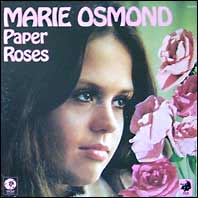Background
In 1973, Marie Osmond's brothers, The Osmonds, were already well-established as stars in the pop music world and as teen idols (especially Donny). The Osmonds' management convinced Marie Osmond to try her hand at singing as well, and soon she was performing with her brothers on tour, but not officially as a member. When she began to record, she took a different tack from her brothers musically: she decided to try to make it big in country music. Osmond was soon signed to MGM Records in Los Angeles, California.
Mike Curb, who had overseen Donny Osmond's solo hit covers of oldies like "Go Away Little Girl", "Puppy Love", "Sweet and Innocent," and "Hey Girl," used the same approach with Marie Osmond. According to Curb in the book Billboard's Hottest Hot 100 Hits by Fred Bronson, when Curb was looking for country songs for her to record for her first album, Sonny James suggested that Osmond sing "Paper Roses."
Release
"Paper Roses" was the first song recorded by Osmond as a solo performer, and also her first single release. The single was released in August 1973. MGM promoted the single first to country radio, and received a favorable reaction to the song from radio stations and disc jockeys. Soon the song became a hit for Osmond, going all the way to number one on the country charts. [8] Before long, the song crossed over to pop radio as well, becoming a number 5 Pop and number 1 Easy Listening singles hit. [9] Coincidentally, on the pop charts, it peaked at the same position as Anita Bryant's version. The album and single both received Gold certifications in the United States.
Upon reaching No. 1, Osmond became—at less than one month after her 14th birthday—the youngest female artist and youngest overall solo artist to reach No. 1 on the Billboard Hot Country Songs chart, a record that still stands as of 2015. In the United Kingdom, where Osmond-mania was just as strong as (if not stronger than) in the United States, "Paper Roses" climbed all the way to number 2 on the UK Singles Chart. Osmond followed up the success of "Paper Roses" with a cover of another Anita Bryant hit from 1960, "My Little Corner of the World," but it didn't fare as well, reaching only number 33 on the country-music charts, and bubbling under the pop charts.
She re-recorded "Paper Roses" with the same producer and in the same studio for her 1990 The Best of Marie Osmond greatest hits album on Curb Records because her record label at the time did not have the rights to include the original recording.
Her "Paper Roses" has been adopted by fans of the Scottish football team Kilmarnock F.C. as the club's anthem and is played at major games throughout the season. [10]

